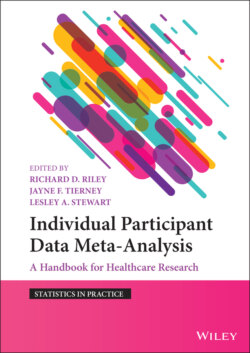Читать книгу Individual Participant Data Meta-Analysis - Группа авторов - Страница 82
4.4.1 Ensuring That IPD Are De‐identified
ОглавлениеIt is important to request that data providers take steps to de‐identify participants in their IPD, before transferring it to the meta‐analysis research team, so as to minimise the risk of participants being re‐identified and their confidentiality being breached.98 De‐identification generally involves the removal of all identifiers that could directly identify individuals, such as participant names and medical or hospital numbers. In an IPD meta‐analysis project, this small degree of de‐identification is the usual process followed by data providers, because the data recipients (i.e. the IPD project’s central research team) will not have access to the full, original (identifying) data. However, the data protection legislation of the country from which the trial originates, or institutional requirements, may necessitate more stringent de‐identification measures, for example, the removal or recoding of indirect or quasi‐identifiers such as dates of birth, and the removal or redaction of free‐text verbatim terms. Direct identifiers may be replaced with new pseudonyms, and quasi‐identifying dates may be removed or generalised to, for example, just the month and year so as to limit the risk of identification.99 As the link between the shared IPD and original trial data is preserved, it remains feasible to consult with trial investigators on any issues that arise at the participant level, and update the IPD as needed.
Figure 4.4 Excerpts from the website https://www.york.ac.uk/crd/research/epppic/ for an IPD meta‐analysis of the effects of progestogens for the prevention of preterm birth.
Source: Evaluating Progestogens for Prevention of Preterm birth International Collaborative, © University of York.
Although with a lesser degree of de‐identification or pseudonymisation there are risks that participants might be identified,99 this is mitigated by the data provider and IPD project’s central research team entering into a data‐sharing agreement. This should specifically prohibit any attempt to identify individuals, and stipulate that the team receiving the data should have data privacy training, and will hold the data securely and use it appropriately (Section 3.11). Data recipients still need to sign data‐sharing agreements to obtain IPD from more public sources, such as data‐sharing platforms or repositories (Section 3.2.2),100 but these data will usually have been subject to a greater degree of de‐identification, because the risks to participant confidentiality are greater with such quasi‐public data.99 Full de‐identification or anonymisation, involving the removal of all links between the de‐identified IPD and the original datasets, limits the utility of the IPD for meta‐analysis and therefore, is not recommended.
Table 4.3 Example of items to include in a data transfer guide when requesting IPD
Source: Jayne Tierney and Larysa Rydzewska.
| Item | Example |
|---|---|
| Preferred file format | Provide electronic data file(s) in Microsoft Excel (.xls or .xlsx), Stata (.dta), SAS (.sas7bdat) or a delimited plain‐text (.csv) format if possible. If you need to use another format, please let us know. |
| Filename instructions | Include a clear trial identifier in the name of any data files provided. |
| Specific trial population | Include all participants recruited to your trial, including those later classed as being ineligible, withdrawn, not evaluable, with protocol deviations, or lost to follow‐up. |
| De‐identification instructions | Do not include any codes or labels that could potentially directly identify participants, such as names, locations, address details, hospital numbers or dates of birth. If only direct identifiers have been used for a particular trial variable (e.g. the participant ID is the participant name), then please replace with a pseudonymised version for each participant and retain the key in case queries arise. |
| Data items and preferred coding | Extract the variables from your trial database that correspond most closely to those requested in the data dictionary. If this is not possible for some or all data items, please use your own codes, but define them clearly in your dataset documentation. |
| Secure data transfer instructions | Transfer the trial data file to us using our secure file transfer service. If the trial data file is transferred by email, ensure that it is secure and end‐to‐end encrypted. |
| Research team contact details | If you have any questions regarding the preparation and transfer of the IPD, please contact Jayne Bloggs (j.bloggs@institute.email). |
